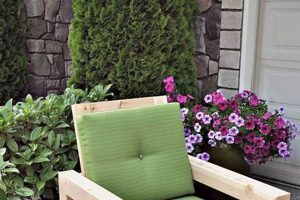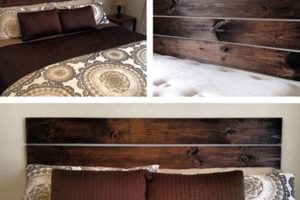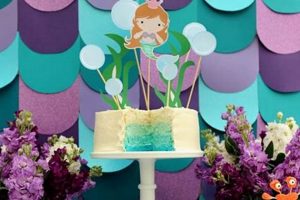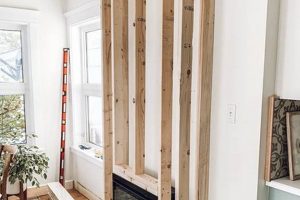The process of transforming an existing chest of drawers through personal creative endeavors is a popular form of upcycling. These projects encompass a wide range of techniques, from simple refinishing to complete structural alterations, typically executed by individuals without professional assistance. An example includes sanding and repainting an old oak dresser with a fresh coat of vibrant blue paint, replacing the hardware with modern knobs, and lining the drawers with decorative paper.
This practice offers several advantages. It provides a cost-effective way to acquire unique furniture pieces that align with specific aesthetic preferences. Furthermore, it promotes sustainability by diverting furniture from landfills and extending the lifespan of existing materials. Historically, repurposing furniture has been a common practice, particularly during times of economic hardship or resource scarcity, evolving from necessity to a recognized art form.
The subsequent sections will delve into diverse approaches for revitalizing dressers, covering preparation techniques, paint application methods, hardware selection, surface embellishments, and creative design concepts to inspire successful transformations.
Essential Strategies for Revitalizing Dressers
The following are recommended guidelines to maximize the success and longevity of dresser transformation projects.
Tip 1: Preparation is Paramount: Prior to commencing any decorative work, thoroughly clean the dresser. Remove all hardware and repair any structural damage. Sanding the existing finish ensures proper adhesion of subsequent coatings. A clean, stable surface is critical for optimal results.
Tip 2: Select Appropriate Materials: Choose paint, stain, and sealant products formulated for the specific type of furniture and intended use. Water-based acrylic paints are generally low-VOC and easy to clean, while oil-based paints offer enhanced durability. Ensure compatibility between primer, paint, and topcoat.
Tip 3: Emphasize Gradual Application: Apply paint or stain in thin, even coats, allowing each layer to dry completely before proceeding. Multiple thin coats are preferable to a single thick coat, which can result in drips, runs, and uneven coverage. Patience during application yields a smoother, more professional finish.
Tip 4: Prioritize Hardware Selection: Replacement hardware can significantly alter the aesthetic of the dresser. Consider the overall style of the piece and select knobs, pulls, or handles that complement the design. Ensure proper fit and secure attachment of new hardware.
Tip 5: Explore Surface Embellishments: Beyond paint and stain, consider incorporating decorative techniques such as stenciling, decoupage, or wood appliqus to add visual interest. These embellishments can personalize the dresser and create a unique statement piece.
Tip 6: Protect the Finished Surface: After completing the decorative work, apply a protective topcoat or sealant to guard against scratches, stains, and moisture damage. Polyurethane, varnish, or wax are common options, each offering varying degrees of protection and sheen.
Tip 7: Conduct a Final Inspection: Upon completion, carefully inspect the dresser for any imperfections or areas requiring touch-up. Ensure all drawers operate smoothly and all hardware is securely fastened. Address any issues promptly to maintain the integrity of the finished piece.
Adherence to these strategies will increase the likelihood of achieving a high-quality, long-lasting transformed dresser.
The concluding section will summarize the key elements of a successful dresser revitalization and offer resources for further exploration.
1. Surface Preparation
Surface preparation is an indispensable preliminary stage in dresser transformation projects, directly impacting the quality and longevity of the subsequent modifications. Proper execution of this phase ensures optimal adhesion of paints, stains, and other finishes, while also addressing pre-existing imperfections that could compromise the final aesthetic.
- Cleaning and Degreasing
Prior to any physical alteration, the removal of dirt, grime, and grease is crucial. This typically involves the use of a degreasing agent and a thorough scrubbing. Failure to adequately clean the surface can result in paint adhesion problems and an uneven finish. For instance, if residue from furniture polish remains on the surface, paint may peel or crack prematurely.
- Sanding
Sanding serves multiple purposes, including smoothing imperfections, creating a textured surface for improved paint adhesion, and removing existing finishes. The grade of sandpaper used depends on the condition of the dresser; coarser grits are suitable for removing heavy coatings, while finer grits are used for smoothing. Inadequate sanding can lead to a rough or uneven final product, and the new finish may not adhere properly to a glossy or non-porous surface.
- Repairing Damage
Addressing structural or cosmetic damage before refinishing is essential. This may involve filling holes or cracks with wood filler, repairing loose joints, or replacing damaged veneers. Neglecting these repairs will result in an unprofessional appearance and potentially compromise the structural integrity of the dresser. For example, a large crack filled with paint rather than wood filler will remain visible and may worsen over time.
- Priming
Application of a primer is often necessary to create a uniform surface for the paint or stain. Primers can block stains from bleeding through the new finish, improve adhesion, and enhance the color vibrancy of the topcoat. Selecting the appropriate primer for the type of paint and the existing surface is crucial. Skipping this step, particularly when painting over dark colors or glossy surfaces, may result in uneven color, poor adhesion, and the need for multiple coats of paint.
These surface preparation facets form the foundation of any successful dresser revitalization. Attention to detail during this initial phase is critical to achieving a durable, aesthetically pleasing transformation. A lack of diligence in cleaning, sanding, repairing, or priming can undermine the entire project, leading to disappointing results and potentially necessitating a complete redo.
2. Color Palette
The selection of a color palette directly influences the success of dresser revitalization projects. It determines the aesthetic impact and how well the refurbished piece integrates into the intended environment. A carefully considered palette ensures visual harmony; conversely, a poorly chosen one can detract from the room’s overall design. For instance, a bright, primary color scheme might be suitable for a child’s room but cl
ash in a living room with muted, neutral tones. The palettes impact extends beyond mere visual appeal, affecting perceived mood and the character of the furniture itself.
Several factors should guide the choice of colors. Existing dcor, including wall colors, flooring, and other furniture, acts as a primary constraint. The dresser’s intended function and the room’s lighting conditions also play a role. For example, a dresser intended for use in a dimly lit hallway might benefit from lighter, more reflective colors to enhance visibility. Additionally, considering the existing style of the dresser itselfwhether it’s a vintage piece or a modern designcan inform the choice of colors that complement its inherent characteristics. A mid-century modern dresser might be enhanced by earth tones or retro-inspired hues, while a rustic dresser could benefit from a whitewashed or distressed finish.
Ultimately, color selection is a critical determinant of the transformed dresser’s success. By understanding the interplay between color, existing dcor, lighting, and furniture style, a revitalized dresser can become a focal point that enhances the room’s overall aesthetic. Challenges arise when trying to match existing colors perfectly or when attempting bold color combinations. Accessing color charts and testing paint samples are essential steps to mitigate these challenges and achieve a desired outcome. Failure to invest appropriate time and consideration into this crucial aspect can lead to a disappointing outcome and necessitate further time and monetary investment for rectification.
3. Hardware Upgrade
The replacement of existing knobs, pulls, and handles represents a pivotal element within the broader scope of dresser transformation endeavors. This facet transcends mere aesthetic considerations, influencing both the functional utility and the overall stylistic identity of the furniture piece.
- Aesthetic Transformation
Replacement hardware offers an opportunity to drastically alter the visual character of a dresser without undertaking extensive refinishing. For instance, swapping outdated brass knobs for sleek, modern chrome pulls can instantly update a dresser’s appearance. This simple change provides a significant impact on the piece’s integration within a contemporary decor scheme. Conversely, antique-style hardware can impart a vintage aesthetic to a more modern piece.
- Functional Improvement
New hardware can enhance the usability of a dresser. Ergonomically designed pulls can be easier to grip than small, poorly shaped knobs. Replacing damaged or malfunctioning hardware ensures smooth drawer operation. Upgrading to self-closing drawer slides paired with appropriate pulls improves both the usability and perceived quality of the dresser.
- Material Considerations
The selection of hardware materials impacts durability and aesthetic appeal. Solid brass hardware offers longevity and a classic appearance. Stainless steel provides corrosion resistance, suitable for environments with higher humidity. Inexpensive materials, such as plastic, may degrade quickly and detract from the overall quality of the makeover.
- Style Compatibility
Ensuring that the chosen hardware complements the dresser’s existing style is critical. Modern dressers often benefit from minimalist, geometric hardware, while antique or vintage dressers may require more ornate, period-appropriate pieces. Mismatched hardware can create a discordant visual effect, diminishing the success of the project.
Consequently, the mindful selection and installation of replacement hardware represent a cost-effective method for enhancing both the form and function of a dresser. A considered approach elevates the overall quality of the transformed piece, contributing significantly to its renewed aesthetic appeal and functional utility.
4. Structural Repairs
Structural repairs form a critical, often underestimated, component of successful dresser revitalization endeavors. These repairs address underlying physical issues that, if uncorrected, can undermine the aesthetic improvements achieved through refinishing or decorative enhancements. The absence of attention to structural integrity can lead to a visually appealing but functionally deficient piece. For instance, a newly painted dresser with unstable legs or drawers that do not operate smoothly represents a failure despite surface-level improvements. The cause-and-effect relationship is direct: neglect of structural issues results in reduced longevity and usability.
The types of repairs commonly encountered include reinforcing loose joints, repairing or replacing damaged drawer slides, addressing warped or split wood panels, and stabilizing weakened legs or supports. Examples range from simple tightening of screws to more complex interventions involving wood glue, clamps, and replacement parts. A real-world scenario might involve a vintage dresser with dovetail joints that have separated over time. Without addressing these loose joints, any refinishing effort is essentially cosmetic and does not address the underlying structural weakness. Proper structural repairs ensure the dresser is not only aesthetically pleasing but also safe and functional for its intended purpose.
In summary, structural repairs are not merely an optional add-on but an integral aspect of any comprehensive dresser revitalization. They provide the foundation upon which aesthetic improvements can be built, ensuring the longevity, stability, and functional utility of the finished piece. Overlooking this stage compromises the entire project. Mastering basic repair techniques is, therefore, essential for individuals pursuing these revitalization projects, allowing for the creation of genuinely renewed and lasting furniture.
5. Finishing Techniques
Finishing techniques represent a critical stage in the transformation of dressers, influencing both the aesthetic outcome and the long-term durability of the piece. This phase involves the application of protective and decorative coatings that enhance the underlying preparation and repair work. The choice and execution of these techniques are essential for achieving a professional-quality result.
- Paint Application
Paint application entails more than simply applying color. Techniques such as brushing, rolling, or spraying each yield distinct finishes. Brush strokes may create a textured surface, while spraying results in a smoother, more uniform appearance. The type of paint used, whether water-based acrylic or oil-based enamel, also affects the final finish. Incorrect paint application can lead to drips, runs, or uneven coverage, detracting from the dresser’s overall aesthetic. For instance, inadequate surface preparation coupled with improper spray technique can result in an “orange peel” texture.
- Staining and Sealing
Staining enhances the natural grain of wood, adding depth and character. This technique often precedes the application of a sealant, such as varnish or polyurethane, which protects the stained surface from moisture and wear. The selection of the appropriate
stain color and sealant type is crucial for achieving the desired aesthetic and level of protection. A poorly applied sealant can result in a cloudy or uneven finish, diminishing the natural beauty of the wood grain. Example- Choosing the wrong varnish for stain can create undesirable finish. - Distressing and Antiquing
Distressing involves intentionally creating a worn or aged appearance, often through sanding, chipping, or applying specialized products. Antiquing techniques use glazes or waxes to highlight details and create a sense of depth. These techniques can add character and charm to a dresser, particularly those intended for vintage or rustic dcor styles. However, over-distressing or improper use of antiquing products can result in an artificial or unconvincing appearance.
- Topcoat Application
The final step of many projects involves applying a topcoat, which provides a protective layer over the paint or stain. Topcoats, such as polyurethane, lacquer, or wax, offer varying levels of durability and sheen. Proper application of a topcoat is essential for preventing scratches, stains, and moisture damage. A poorly applied topcoat can result in brush marks, bubbles, or an uneven sheen, compromising the overall finish of the dresser.
In conclusion, mastering the diverse array of finishing techniques is paramount for successful dresser revitalization projects. From paint and stain to distressing and topcoat application, each technique plays a crucial role in achieving the desired aesthetic and ensuring the long-term durability of the finished piece. A considered approach to these techniques is critical for transforming a dresser into a unique and visually appealing element within a room’s decor.
6. Style Integration
The convergence of “diy dresser makeover ideas” and style integration represents a pivotal aspect of successful furniture revitalization projects. Style integration, in this context, refers to the harmonizing of a refurbished dresser with the existing aesthetic of its intended environment. A disconnected piece, regardless of its individual aesthetic merits, will detract from the overall cohesiveness of a room’s design. This emphasizes that the transformation process extends beyond mere surface alterations; it necessitates a comprehensive understanding of the room’s style and the dresser’s role within it.
Consider a scenario involving a modern minimalist bedroom. The introduction of a heavily ornamented, Victorian-style dresser, even if expertly refinished, would likely create a visual conflict. Conversely, a dresser revitalized with clean lines, neutral colors, and simple hardware would seamlessly integrate into the existing design scheme, enhancing rather than detracting from the room’s intended aesthetic. This example illustrates the cause-and-effect relationship between style integration and the overall success of the makeover. A lack of consideration for existing decor inevitably leads to a visually jarring result. The practical application of this understanding lies in careful planning. Before commencing any physical alterations, an assessment of the room’s style, color palette, and furniture arrangement is essential.
In conclusion, style integration is not merely a desirable addendum to “diy dresser makeover ideas”; it is a fundamental requirement for creating a cohesive and aesthetically pleasing living space. The challenges encountered often involve balancing personal preferences with the constraints of existing decor. However, by prioritizing style integration, these projects can transform a simple furniture revitalization into a meaningful enhancement of a room’s overall design. The absence of its consideration leaves potential unrealized and aesthetics imbalanced.
Frequently Asked Questions Regarding Dresser Revitalization
This section addresses common inquiries and misconceptions surrounding the process of transforming existing dressers, providing objective answers to aid in successful project execution.
Question 1: Is sanding always necessary when revitalizing a dresser?
Sanding is generally recommended to ensure proper adhesion of new finishes, particularly if the existing surface is glossy or damaged. However, certain specialized paints marketed as “no-sand” may be viable alternatives for specific projects, but their effectiveness can vary.
Question 2: What are the most durable paint options for a dresser intended for heavy use?
Oil-based enamel paints offer superior durability compared to water-based acrylics, providing enhanced resistance to scratches, stains, and chipping. However, oil-based paints require longer drying times and specialized cleaning solvents.
Question 3: How can brush strokes be minimized when painting a dresser?
Employing high-quality brushes designed for smooth finishes, thinning the paint slightly, and applying thin, even coats can minimize brush strokes. Sanding lightly between coats can also create a smoother surface.
Question 4: What is the best method for removing old hardware without damaging the dresser?
Carefully examine the hardware attachment mechanisms and use appropriate tools, such as screwdrivers or pliers, to loosen and remove fasteners. Avoid excessive force, which can damage the surrounding wood.
Question 5: How can damage to the surrounding floor be prevented during dresser revitalization?
Place a drop cloth or protective sheeting beneath the dresser to capture paint drips, sanding dust, and other debris. Exercise caution when moving the dresser to avoid scratching or denting the floor.
Question 6: What safety precautions should be observed during dresser revitalization projects?
Work in a well-ventilated area to minimize exposure to paint fumes and dust. Wear appropriate personal protective equipment, such as safety glasses, a dust mask, and gloves, to protect against hazards.
Adhering to these guidelines can mitigate common pitfalls and improve the likelihood of a successful dresser transformation. The ultimate success depends on meticulousness and awareness.
The next article section will provide a concluding summary of the vital elements for a quality restoration and offer resources to assist further exploration.
Concluding Remarks on Dresser Revitalization
This discourse provided a comprehensive overview of “diy dresser makeover ideas,” emphasizing surface preparation, color palette selection, hardware upgrades, structural repairs, finishing techniques, and style integration as fundamental components. The exploration underscored the necessity of meticulous planning and execution to achieve aesthetically pleasing and functionally sound results. Furthermore, the analysis illustrated how the skillful application of these principles can extend the lifespan of existing furniture, promote sustainability, and allow individuals to create unique pieces tailored to specific needs and preferences.
The successful implementation of “diy dresser makeover ideas” requires careful consideration and dedicated effort. While the process presents challenges, the ability to transform discarded furniture into valuable assets represents a compelling opportunity for resourcefulness and creativity. Prospective renovators are encouraged to approach each project with a commitment to quality and a willingness to invest the time and effort necessary to realize their vision, thus contributing to a more sustainable and aesthetically enriched environment.







